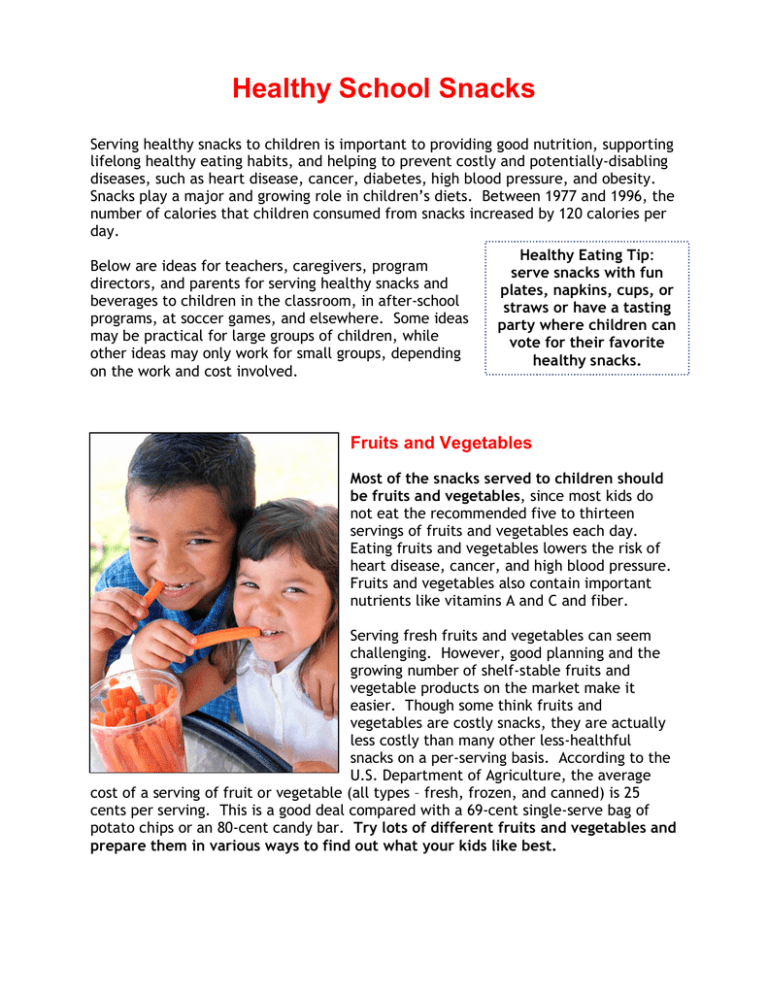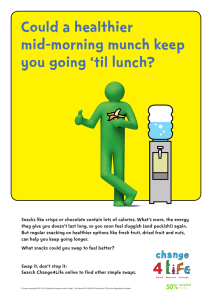Healthy School Snacks
advertisement

Healthy School Snacks Serving healthy snacks to children is important to providing good nutrition, supporting lifelong healthy eating habits, and helping to prevent costly and potentially-disabling diseases, such as heart disease, cancer, diabetes, high blood pressure, and obesity. Snacks play a major and growing role in children’s diets. Between 1977 and 1996, the number of calories that children consumed from snacks increased by 120 calories per day. Below are ideas for teachers, caregivers, program directors, and parents for serving healthy snacks and beverages to children in the classroom, in after-school programs, at soccer games, and elsewhere. Some ideas may be practical for large groups of children, while other ideas may only work for small groups, depending on the work and cost involved. Healthy Eating Tip: serve snacks with fun plates, napkins, cups, or straws or have a tasting party where children can vote for their favorite healthy snacks. Fruits and Vegetables Most of the snacks served to children should be fruits and vegetables, since most kids do not eat the recommended five to thirteen servings of fruits and vegetables each day. Eating fruits and vegetables lowers the risk of heart disease, cancer, and high blood pressure. Fruits and vegetables also contain important nutrients like vitamins A and C and fiber. Serving fresh fruits and vegetables can seem challenging. However, good planning and the growing number of shelf-stable fruits and vegetable products on the market make it easier. Though some think fruits and vegetables are costly snacks, they are actually less costly than many other less-healthful snacks on a per-serving basis. According to the U.S. Department of Agriculture, the average cost of a serving of fruit or vegetable (all types – fresh, frozen, and canned) is 25 cents per serving. This is a good deal compared with a 69-cent single-serve bag of potato chips or an 80-cent candy bar. Try lots of different fruits and vegetables and prepare them in various ways to find out what your kids like best. Fruit is naturally sweet, so most kids love it. Fruit can be served whole, sliced, cut in half, cubed, or in wedges. Canned, frozen, and dried fruits often need little preparation. v Apples (it can be helpful to use an apple corer) v Apricots v Bananas v Blackberries v Blueberries v Cantaloupe v Cherries v Grapefruit v Grapes (red, green, or purple) v Honeydew Melon v Kiwis (cut in half and give each child a spoon to eat it) v v v v v v v v v v v v Mandarin Oranges Mangoes Nectarines Oranges Peaches Pears Pineapple Plums Raspberries Strawberries Tangerines Watermelon Applesauce (Unsweetened), Fruit Cups, and Canned Fruit – These have a long shelf life and are low-cost, easy, and healthy if canned in juice or light syrup. Examples of unsweetened applesauce include Mott’s Natural Style and Mott’s Healthy Harvest line. Dole and Del Monte offer a variety of single-serve fruit bowls. Dried Fruit - Try raisins, apricots, apples, cranberries, pineapple, papaya, and others with little or no added sugars. Frozen Fruit – Try freezing grapes or buy frozen blueberries, strawberries, peaches, mangoes, and melon. Fruit Leathers – Some brands of fruit snacks are more like candy than fruit, and should be avoided due to their high content of added sugars and lack of fruit. Brands to avoid include Fruit Rollups, Farley’s Fruit Snacks, Sunkist Fruit Gems, Starburst Fruit Chews, Mamba Fruit Chews, Jolly Rancher Fruit Chews, Original Fruit Skittles, and Amazin’ Fruit Gummy Bears. Try Natural Value Fruit Leathers and Stretch Island Fruit Leathers, which come in a variety of flavors and don’t have added sugars. Fruit Salad – Get kids to help make a fruit salad. Use a variety of colored fruits to add to the appeal. Popsicles – Most so-called “fruit” popsicles have added sugars and should be reserved for an occasional treat. Look for popsicles made from 100% fruit juice with no added caloric sweeteners, such as Breyers or Dole “No Sugar Added” fruit bars. 2 Smoothies – Blend fruit with juice, yogurt or milk, and ice. Many store-made smoothies have added sugars and are not healthy choices. Deliveries – Deliveries of fresh fruit or platters of cut-up fruit are a convenient option offered by some local grocery stores. Vegetables can be served raw with dip or salad dressing: v Broccoli v Carrot sticks or Baby Carrots v Cauliflower v Celery Sticks v Cucumber v Peppers (green, red, or yellow) v Snap Peas v Snow Peas v String Beans v Tomato slices or grape or cherry tomatoes v Yellow Summer Squash slices v Zucchini slices Dips – Try low-fat salad dressings, like fat-free Ranch or Thousand Island, store-bought light dips, bean dips, guacamole, hummus (which comes in dozens of flavors), salsa, or peanut butter. Salad – Make a salad or set out veggies like a salad bar and let the kids build their own salads. Soy - Edamame (pronounced “eh-dah-MAH-may”) are fun to eat and easy to serve. (Heat frozen edamame in the microwave for about 2-3 minutes). Veggie Pockets – Cut whole wheat pitas in half and let kids add veggies with dressing or hummus. Ants on a Log – Let kids spread peanut butter on celery (with a plastic knife) and add raisins. Healthy Grains (bread, crackers, cereals, etc.) Though most kids eat plenty of grain products, too many of those grains are cookies, snack cakes, sugary cereals, Rice Krispy treats, and other refined grains that are high in sugars or fat. Try to serve mostly whole grains, which provide more fiber, vitamins, and minerals than refined grains. In addition, try to keep the added sugars to less than 35% by weight1,2 and the saturated and If a food manufacturer fails to provide the added sugars content of a food item, use the percentage of weight from total sugars (in place of the percentage of weight from added sugars), and exempt fruits, vegetables, and dairy foods from this total sugars limit. 1 3 trans fat low (i.e., less than 10% of calories, or about one gram or less per serving). Note: Cookies, snack cakes, and chips should be saved for occasional treats, given their poor nutritional quality. Whole Wheat English Muffins, Pita, or Tortillas – Stuff them with veggies or dip them in hummus or bean dip. Breakfast Cereal – Either dry or with low-fat milk, whole grain cereals like Cheerios, Grape-Nuts, Raisin Bran, Frosted Mini Wheats, and Wheaties make good snacks. Look for cereals with no more than 35% added sugars by weight1 (or roughly 8 grams of sugar per serving). Crackers – Whole-grain crackers like Triscuits, which come in different flavors or thin crisps (or similar woven wheat crackers), Kalvi Rye crackers, or whole wheat Matzos can be served alone or with toppings, like low-fat cheese, peanut butter, or low-fat, reduced-sodium luncheon meat. Rice Cakes - Look for rice cakes made from brown (whole grain) rice. They come in many flavors, and can be served with or without toppings. Popcorn – Look for low-fat popcorn in a bag or microwave popcorn. Or you can air pop the popcorn and season it, e.g., by spraying it with vegetable oil spray and adding parmesan cheese, garlic powder, or other non-salt spices. Baked Tortilla Chips - Baked tortilla chips are usually low in fat, and taste great with salsa and/or bean dip. Look for brands with less sodium. Granola and Cereal Bars - Look for whole grain granola bars that are low in fat and sugars, like Barbara’s Granola Bars (cinnamon raisin, oats and honey, and carob chip flavors), Nature Valley Crunchy Granola Bars (cinnamon, oats ‘n honey, maple brown sugar, and peanut butter flavors), Nature Valley Chewy Trail Mix Bars (fruit and nut flavor), and Quaker Chewy Granola Bar (peanut butter and chocolate chunk flavor). Pretzels, Breadsticks, and Flatbreads - These low-fat items can be offered as snacks now and then. However, most of these snacks are not whole grain and most pretzels are high in salt. To calculate % sugars by weight for a food item, look at the Nutrition Facts label and divide the grams of sugars by the gram weight of one serving of the product and multiply this number by 100. 2 4 Low-Fat Dairy Foods Dairy foods are a great source of calcium, which can help to build strong bones. However, dairy products also are the biggest sources of artery-clogging saturated fat in kids’ diets. To protect children’s bones and hearts, make sure all dairy foods served are low-fat or fat-free. Yogurt – Look for brands that are low-fat or fat-free, moderate in sugars (no more than about 30 grams of sugars in a 6-oz. cup), and high in calcium (at least 25% of daily value [DV] for calcium in a 6-oz. cup). Examples include Danimals Drinkable Low-Fat Yogurt, Go-Gurt by Yoplait, or cups of low-fat or non-fat yogurt from Stonyfield Farm, Dannon, Horizon, and similar store brands. Low-fat or non-fat yogurt also can be served with fresh or frozen fruit or low-fat granola. Low-Fat Cheese - Cheese provides calcium, but often its saturated fat price tag is too high. Cheese is the number two source of heart-damaging saturated fat in children’s diets. Even with low-fat and reduced-fat cheese, be sure to serve with other foods like fruit, vegetables, or whole grain crackers. Choose reduced-fat cheeses like Trader Joe’s Armenian Style Braided; Borden or Sargento Light Mozzarella string cheese; Frigo Light Cheese Heads; Kraft TwistUms; Polly-O Twisterellas; the Laughing Cow’s Light Original Mini Babybel; or Cabot 50% Light Vermont Cheddar. Low-Fat Pudding and Frozen Yogurt - Low-fat or fat-free pudding and frozen yogurt should be served only as occasional treats, because they are high in added sugars. Other Snack Ideas Nuts - Since nuts are high in calories, it is best to serve them along with another snack such as fruit. A small handful of nuts is a reasonable serving size. Examples include peanuts, pistachios, almonds, walnuts, cashews, or soy nuts. Look for nuts that are unsalted. WARNING: A small but growing number of kids have severe peanut and/or tree nut allergies. Before bringing in peanuts, peanut butter, or other nuts as a snack, check to make sure none of the children has an allergy. Trail Mix - Trail mixes are easy to make and store well in a sealed container. Items to include: low-fat granola, whole grain cereals, peanuts, cashews, almonds, sunflower seeds, pumpkin seeds, and dried fruits like raisins, apricots, apples, pineapple, or cranberries. 5 Luncheon Meat – Choose lower-fat, reduced-sodium brands of turkey, ham, and roast beef and serve with whole wheat bread, pita, tortillas (as a wrap sandwich), or crackers. Cut sandwiches in half to make snack-sized portions. Healthy Beverages Water – Water should be the main drink served to kids at Water satisfies thirst and does not have sugar or calories. (Plus, it is low-cost for care-givers!) If kids are used to getting sweetened beverages at snack times, it may take a little time for them to get used to drinking water. snack times. Water should be the main drink served to kids at snack times. Seltzer - Carbonated drinks like seltzer, sparkling water, and club soda are healthy options. They do not contain the sugars, calories, and caffeine of sodas. Serve them alone or try making “healthy sodas” by mixing them with equal amounts of 100% fruit juice. Low-Fat and Fat-Free Milk - Milk provides key nutrients, such as calcium and vitamin D. Choose fat-free (skim) or low-fat (1%) milk to avoid the heart-damaging saturated fat found in whole and 2% (reduced-fat) milk. It is best to serve fat-free versions of chocolate, strawberry, or other flavored milks to help balance the extra calories coming from added sugars. Single-serve containers of chocolate or other flavored whole or 2% milk drinks can be too high in calories (400-550 calories) and saturated fat (1/3 of a day’s worth) to be a healthy beverage for kids. Soy and Rice Drinks - For children who prefer not to drink cow’s milk, calciumfortified soy and rice drinks are good choices. Fruit Juice - Try to buy 100% fruit juice and avoid the added sugars of juice drinks, punches, fruit cocktail drinks, or lemonade. Drinks that contain at least 50% juice and no additional caloric sweeteners are also healthful options. To find 100% juice, look at beverage nutrition labels for the percentage of the beverage that is juice. Orange, grapefruit, and pineapple juices are more nutrient-dense and are healthier than apple, grape, and pear juices. (See “Orange You Glad?” chart.) Many beverages like Capri Sun, V8-Splash, Tropicana Twisters, Sunny Delight, Kool Aid Jammers, Hi-C, or juice drinks from Very Fine, Welch’s or Snapple are easily mistaken for juice. However, those beverages are more like soda than juice -- they are merely sugar water with a few tablespoons of added juice. Fruit juice can be rich in vitamins, minerals, and cancer-fighting compounds. However, it is high in calories. The American Academy of Pediatrics 6 1% recommends that children ages 1-6 years old drink no more than 6 ounces (one serving) of juice a day and children ages 7-18 years old drink no more than 12 ounces (two servings) of juice a day. A note about sugary soft drinks (soda, sweetened tea, lemonade, and juice drinks): Children who drink more sweetened drinks consume more calories and are more likely to be overweight than kids who drink fewer soft drinks. Soft drinks also displace healthful foods in kids’ diets like milk, which can help prevent osteoporosis, and 100% juice, which can help prevent heart disease and cancer. In addition, soda pop can cause dental cavities and tooth decay. ****************************************************************************** For more information, contact Dr. Margo Wootan or Joy Johanson at the Center for Science in the Public Interest, 1875 Connecticut Avenue, NW, Suite 300; Washington, DC 20009. Phone: 202-777-8351, Fax: 202-265-4954, E-mail: <jjohanson@cspinet.org>. 7






